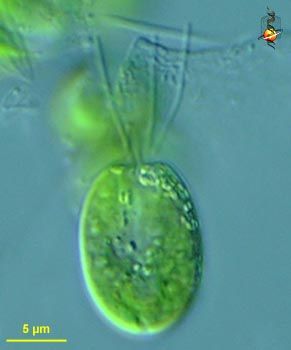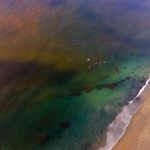If you were at the beach in San Diego this weekend, especially off La Jolla Shores, you might have seen streaks of green sea foam. Here’s a stunning photo of the foam off Scripps pier, taken by Eddie Kisfaludy from a small plane 1,500 feet above the ocean.

This foam is the harmless microscopic algae Tetraselmis spp. From the Southern California Coastal Ocean Observing System:
The harmless, green foam has returned yet another year to San Diego County beaches. Researchers at Scripps Institution of Oceanography have determined that the bright green color is caused by a bloom of phytoplankton, Tetraselmis spp. This green flagellate is roughly 10 micrometers in size, and has been found in concentrations as dense as 15 million cells per liter of seawater. The foam has become more prevalent this week, though it has been observed off and on since the first week of July. It’s patchy distribution makes it visible only at some beaches and the foam becomes more apparent in the afternoon when the wind and waves mix the surface waters. Tetraselmis has bloomed each summer since 2009 with blooms lasting from one week to several months. There are no documented health hazards with swimming or fishing in areas of Tetraselmis blooms.
Here’s what Tetraselmis looks like – isn’t it cute?

Though you still need to take some care around stingrays and sea nettle jellyfish, there’s no need to worry about the green streaks. Get in the water and enjoy the pretty southern California summer!






Any possibility that this bloom could have resulted in the creation of enough volatile sulfur compounds to explain the nasty smell that occurred from Oceanside to Del Mar last week?
Thanks
What’s the process that causes this bloom so late into the year? Always associated blooms with upwelling at the beginning of spring. I don’t quite get summer blooms!
I don’t know, but I sent your question to Melissa Carter (phytoplankton researcher at Scripps).
These summer blooms are probably caused by stratification of the water column. This means that there’s not very much mixing from the top to the bottom (and vice-versa) so the warm water is sitting on top and the cold water is sitting on the bottom. Certain types of algae really like that environment. Here’s a good, though somewhat technical, explanation.
Melissa writes: “It’s a possibility but I don’t know for sure. I’m not sure how concentrated the bloom of Tetraselmis was up there, but we haven’t smelled any sulfur type smells here in La Jolla and the bloom has been pretty dense here. Some marine phototrophs can produce dimethylsulfoniopropionate (DMSP) which can smell like rotten eggs when decomposing in anoxic environments. One species within the genus Tetraselmis has been noted in one study to produce DMSP but there are several species so I don’t have a definitive answer for you about the species we are seeing now and it’s ability to produce DMSP. Keep in mind we are also having extreme tides right now that can expose the sediment in the wetlands and these areas often are quite pungent!”
Very cool! I’d learned as much to know that the mixing (and thus bringing nutrients to the surface) was the reason for the spring blooms. Didn’t know there were algae out there that actually -prefer- it to be warm, calm, and fairly nutrient-poor (if I’m understanding that right?). Thx much, great report.
Well, the theory it is that mixing, followed by stratification, is the optimal conditions for some bloom-forming algae. That way there are nutrients on the surface, but the algae isn’t getting mixed down & disturbed by turbulence. The causes driving algal blooms is definitely a really active area of research, though, and I’m not an expert in it.
Is this the same algae that caused the blue glow from last summer? If it is, is it still happening?
It’s a different kind of algae, which doesn’t glow. It’s also gone, I’m afraid.
There is so much variety of different algae and that leads to so many different colors that i am confused. I was reading a post form last year’s red tide in long beach and adjacent areas. It mentioned a fluorescent Algae whose name i forgot. Suddenly in a later somebody mentioned k.brevis which seems to be main cause of red tides in floridA. Now i am confused. Do we have k.brevia here during red tide or not. If somebody can help me understand i would be so thankful!
Yelena, you are correct that there are many, many types of algae. You can read here about the species of red tide algae found in southern California – K. brevia is not among them.
Thank you. That page made it all clear. :) there is a rt-pcr based method of identifying k.brevia. Do you know if there are similar ones for our california red tide species?
I don’t know. I believe the SCCOOS folks ID them based on morphology.